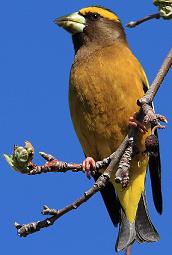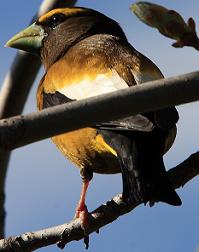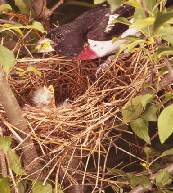 Evening Grosbeak
Evening Grosbeak
Evening Grosbeaks can be attracted to your
yard with food, water and landscaping.
When I think of my favorite birds grosbeaks is near the top.
Where I grew up in Montana we would get huge flocks of these
colorful birds. We had quite a few fruit, berry, and maple
trees, and the birds could not resist them. They seem to
especially like the Mountain Ash berries.
Identification - Pictures and Video

Evening grosbeaks (Coccothraustes
Vespertinus) are stocky short tailed birds about 8
inches, and look much like an over grown goldfinch. They are
members of the finch family, which is the largest bird family
in North America. Others in this family are buntings,
cardinals, crossbills, finches, juncos, redpolls, siskin,
sparrows, and towhees.
Males are dull yellow with a dark head, and
yellow stripe above the eye. The wings, and tail are black,
and there is a large white wing patch.
The female is mostly silver-gray with touches of yellow. The
wings, and tail are black with white patches, not as
pronounced as the mail.
Their large conical bill tells us
they feed mainly on seeds.
The bill is a whitish or greenish color in the summer, and
turns to pale yellow in the winter.
Video below is Evening grosbeaks feeding on sunflower seeds at
a bird feeder.
For
other bird videos please visit our Youtube channel and
subscribe or like our videos.
Most videos on my site were taken with the camcorder.
Song and Calls
Grosbeaks have a ringing chirp or cleer,
and a loud cleep call. They also have a short warble
song.
Evening Grosbeak: Click
for Sound Pine Grosbeak: Click for Sound
Range and Habitat
Grosbeaks can be found year round in northwestern U.S., and
southern Canada. They range from the Rocky Mountain region
south to northern Mexico. They winter in Mexico, and most of
the U.S.
Photos by Keith Lee. The
camera I use is the Canon
EOS 40D. Visit All-birds store
There are a number of different grosbeaks having varied ranges. Others are; Blue,
Rose-breasted, Black-headed, and Pine grosbeaks.
Grosbeaks like mixed forests. They prefer conifer, and spruce
forests. They also like fruit and berry trees or shrubs and
maples. In winter they can be found in open areas with trees
and shrubs, and at your feeders.
Breeding and Nesting
Breeding in open woodlands begins in mid May
in the South, and mid June in the North. The male will court a female by dancing in front of her with
drooped, vibrating wings.
The nest, built mostly by female is constructed
loosely from sticks, moss, lichen, and rootlets.
The
inside can have hair, and plant fibers.
The female will incubate 2 to 5 smooth glossy eggs.
They are light blue or greenish blue. Eggs are
spotted with blotches of purplish to olive brown or
purplish-gray, mostly at the large end. The young are
fed by both parents, and can leave the nest in around
2 weeks. |

Rose-breasted Gosbeak by Steve
Maslowski US Wildlife |

Food and Feeding
Natural foods are seeds, buds, insects,
berries, and fruit. Favorite foods are pine, and box elder
seeds. Grosbeaks forage in trees, shrubs and on the
ground. They forage together in large
flocks.
You can attract grosbeaks to feeders with sunflower seeds.
Large flocks can descend on your feeders, and eat all the
sunflower seeds you have. Some years you may see these flocks
at feeders, while in other years they stay in the north and
are not seen their winter range. Large southern movements
called irruptions are thought to be caused by periodic food
shortages.
For more on food
and feeding click here.
For more on feeders click here.

|
